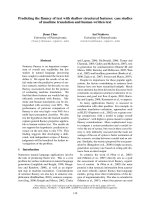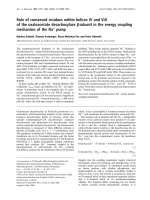efficiency and sustainability in the energy and chemical industries scientific principles and case studies
Bạn đang xem bản rút gọn của tài liệu. Xem và tải ngay bản đầy đủ của tài liệu tại đây (5.58 MB, 396 trang )
EFFICIENCY and
SUSTAINABILITY
in the ENERGY
and CHEMICAL
INDUSTRIES
SECOND EDITION
Scientific Principles
and Case Studies
GREEN CHEMISTRY AND CHEMICAL ENGINEERING
Series Editor: Sunggyu Lee
Missouri University of Science and Technology, Rolla, USA
Efficiency and Sustainability in the Energy and Chemical Industries: Scientific Principles
and Case Studies, Second Edition
Krishnan Sankaranarayanan, Hedzer J. van der Kooi, and Jakob de Swaan Arons
Proton Exchange Membrane Fuel Cells: Contamination and Mitigation Strategies
Hui Li, Shanna Knights, Zheng Shi, John W. Van Zee, and Jiujun Zhang
Proton Exchange Membrane Fuel Cells: Materials Properties and Performance
David P. Wilkinson, Jiujun Zhang, Rob Hui, Jeffrey Fergus, and Xianguo Li
Solid Oxide Fuel Cells: Materials Properties and Performance
Jeffrey Fergus, Rob Hui, Xianguo Li, David P. Wilkinson, and Jiujun Zhang
CRC Press is an imprint of the
Taylor & Francis Group, an informa business
Boca Raton London New York
EFFICIENCY and
SUSTAINABILITY
in the ENERGY
and CHEMICAL
INDUSTRIES
SECOND EDITION
Krishnan Sankaranarayanan
Hedzer J. van der Kooi
Jakob de Swaan Arons
Scientific Principles
and Case Studies
CRC Press
Taylor & Francis Group
6000 Broken Sound Parkway NW, Suite 300
Boca Raton, FL 33487-2742
© 2010 by Taylor and Francis Group, LLC
CRC Press is an imprint of Taylor & Francis Group, an Informa business
No claim to original U.S. Government works
Printed in the United States of America on acid-free paper
10 9 8 7 6 5 4 3 2 1
International Standard Book Number-13: 978-1-4398-1471-0 (Ebook-PDF)
This book contains information obtained from authentic and highly regarded sources. Reasonable efforts
have been made to publish reliable data and information, but the author and publisher cannot assume
responsibility for the validity of all materials or the consequences of their use. The authors and publishers
have attempted to trace the copyright holders of all material reproduced in this publication and apologize to
copyright holders if permission to publish in this form has not been obtained. If any copyright material has
not been acknowledged please write and let us know so we may rectify in any future reprint.
Except as permitted under U.S. Copyright Law, no part of this book may be reprinted, reproduced, transmit-
ted, or utilized in any form by any electronic, mechanical, or other means, now known or hereafter invented,
including photocopying, microfilming, and recording, or in any information storage or retrieval system,
without written permission from the publishers.
For permission to photocopy or use material electronically from this work, please access www.copyright.
com ( or contact the Copyright Clearance Center, Inc. (CCC), 222 Rosewood
Drive, Danvers, MA 01923, 978-750-8400. CCC is a not-for-profit organization that provides licenses and
registration for a variety of users. For organizations that have been granted a photocopy license by the CCC,
a separate system of payment has been arranged.
Trademark Notice: Product or corporate names may be trademarks or registered trademarks, and are used
only for identification and explanation without intent to infringe.
Visit the Taylor & Francis Web site at
and the CRC Press Web site at
To our children and grandchildren who may witness
the emergence of a sustainable society
vii
Contents
Preface xv
About This Book xix
Acknowledgments xxi
Authors xxiii
IPart Basics
1 Introduction 3
References 6
2 Thermodynamics Revisited 7
2.1 The System and Its Environment 7
2.2 States and State Properties 7
2.3 Processes and Their Conditions 8
2.4 The First Law 8
2.5 The Second Law and Boltzmann 11
2.6 The Second Law and Clausius 12
2.7 Change in Composition 13
2.8 The Structure of a Thermodynamic Application 18
References 21
3 Energy “Consumption” and Lost Work 23
3.1 Introduction 23
3.2 The Carnot Factor 24
3.3 Lessons from a Heat Exchanger 25
3.4 Lost Work and Entropy Generation 29
3.5 Conclusion 31
References 31
4 Entropy Generation: Cause and Effect 33
4.1 Equilibrium Thermodynamics 33
4.2 On Forces and Flows: Cause and Effect 34
4.3 Cause and Effect: The Relation between Forces and Flows 36
4.4 Coupling 38
4.5 Limited Validity of Linear Laws 40
4.6 Conclusion 46
References 46
viii Contents
5 Reduction of Lost Work 47
5.1 A Remarkable Triangle 47
5.2 Carnot Revisited: From Ideal to Real Processes 49
5.3 Finite-Time, Finite-Size Thermodynamics 54
5.4 The Principle of Equipartitioning 55
5.5 Conclusions 58
References 58
IPart I Thermodynamic Analysis of Processes
6 Exergy, a Convenient Concept 63
6.1 Exergy 63
6.2 The Convenience of the Exergy Concept 66
6.2.1 Out of Equilibrium with the Environment: What It
Takes to Get There 67
6.2.2 Out of Equilibrium with the Environment: What It
Takes to Stay There 68
6.2.3 Dissipative Structures 69
6.2.4 Physical and Chemical Exergy 70
6.3 Example of a Simple Analysis 71
6.4 The Quality of the Joule 74
6.5 Example of the Quality Concept 77
6.6 Conclusions 80
References 81
7 Chemical Exergy 83
7.1 Introduction 83
7.2 Exergy of Mixing 83
7.3 Chemical Exergy 84
7.3.1 Reference Components from Air 85
7.3.2 Exergy Values of the Elements 86
7.3.3 Chemical Exergy Values of Compounds 88
7.3.4 The Convenience of the Chemical Exergy Concept 89
7.4 Cumulative Exergy Consumption 90
7.5 Conclusions 91
References 92
8 Simple Applications 93
References 105
Contents ix
IIPart I Case Studies
9 Energy Conversion 109
9.1 Introduction 109
9.2 Global Energy Consumption 110
9.3 Global Exergy Flows 112
9.4 Exergy or Lost Work Analysis 115
9.5 Electric Power Generation 115
9.5.1 Steam Plants 116
9.5.2 Gas Turbines 116
9.5.3 Combined Cycle 117
9.5.4 Nuclear Power 118
9.5.5 Hydropower 120
9.5.6 Wind Power 120
9.5.7 Solar Power 121
9.5.8 Geothermal Energy 121
9.6 Coal Conversion Processes 121
9.6.1 Fixed or Moving Beds 122
9.6.2 Suspended Beds 122
9.6.3 Fluidized Beds 122
9.6.4 Thermodynamic Analysis of Coal Combustion 123
9.6.5 Discussion 124
9.6.6 Coal Gasi cation 125
9.7 Thermodynamic Analysis of Gas Combustion 128
9.7.1 Exergy In 128
9.7.2 Air Requirements 128
9.7.3 Exergy Out 130
9.7.4 Ef ciency 132
9.7.5 Discussion 133
9.8 Steam Power Plant 134
9.9 Gas Turbines, Combined Cycles, and Cogeneration 135
9.9.1 Gas Turbines 136
9.9.2 Thermodynamic Analysis of Gas Turbines 136
9.9.3 Combined Cycles, Cogeneration, and Cascading 137
9.9.4 Example 138
9.10 Concluding Remarks 139
References 140
10 Separations 141
10.1 Introduction 141
10.2 Propane, Propylene, and Their Separation 141
10.2.1 Single-Column Process 142
x Contents
10.2.2 Double-Column Process 142
10.2.3 Heat Pump Process 143
10.3 Basics 144
10.3.1 Flash Distillation 144
10.3.2 Multistage Distillation and Re ux 145
10.4 The Ideal Column: Thermodynamic Analysis 149
10.5 The Real Column 152
10.6 Exergy Analysis with a Flow Sheet Program 155
10.7 Remedies 157
10.7.1 Making Use of Waste Heat 157
10.7.2 Membranes 158
10.7.3 Other Methods 159
10.8 Concluding Remarks 160
References 161
11 Chemical Conversion 163
11.1 Introduction 163
11.2 Polyethylene Processes: A Brief Overview 164
11.2.1 Polyethylene High-Pressure Tubular Process 166
11.2.2 Polyethylene Gas-Phase Process 167
11.3 Exergy Analysis: Preliminaries 168
11.4 Results of the HP LDPE Process Exergy Analysis 169
11.5 Process Improvement Options 171
11.5.1 Lost Work Reduction by the Use of a Turbine 172
11.5.2 Alternative to the Extruder 172
11.5.3 Process Improvement Options: Estimated
Savings 173
11.6 Results of the Gas-Phase Polymerization Process Exergy
Analysis 174
11.7 Process Improvement Options 175
11.7.1 Coupling Reactions and Chemical Heat Pump
System 176
11.7.2 Exergy Loss Reduction by Recovering Butylene
and Ethylene from Purge Gas 177
11.7.3 Heat Pump and Preheating of Polymer 177
11.7.4 An Alternative to the Extruder 179
11.7.5 Process Improvement Options: Estimated Savings 180
11.8 Concluding Remarks 181
References 181
12 A Note on Life Cycle Analysis 183
12.1 Introduction 183
12.2 Life Cycle Analysis Methodology 184
12.2.1 Goal and Scope 184
12.2.2 Inventory Analysis 186
Contents xi
12.2.3 Impact Assessment 187
12.2.4 Interpretation and Action 188
12.3 Life Cycle Analysis and Exergy 188
12.4 Zero-Emission ELCA 189
12.5 Concluding Remarks 191
References 191
IPart V Sustainability
13 Sustainable Development 195
13.1 Sustainable Development 195
13.1.1 Three Views 197
13.1.2 Some Other Views 197
13.2 Nature as an Example of Sustainability 198
13.3 A Sustainable Economic System 200
13.3.1 Thermodynamics, Economics, and Ecology 200
13.3.2 Economics and Ecology 203
13.3.3 Nature’s Capital and Services 205
13.3.4 Adjustment of the Gross National Product 206
13.3.5 Intermezzo: Thermodynamics and Economics—A
Daring Comparison and Analogy 206
13.4 Toward a Solar-Fueled Society: A Thermodynamic
Perspective 211
13.4.1 Thermodynamic Analysis of a Power Station 211
13.4.2 Some Observations 213
13.4.3 From Fossil to Solar 213
13.5 Ecological Restrictions 214
13.5.1 Ecological Footprint 214
13.5.2 Waste 218
13.6 Thermodynamic Criteria for Sustainability Analysis 221
13.6.1 Introduction 221
13.6.2 Sustainable Resource Utilization Parameter α 222
13.6.3 Notes on Determining Depletion Times
and Abundance Factors 227
13.6.4 Exergy Ef ciency η 228
13.6.5 The Environmental Compatibility ξ 229
13.6.6 Determining Overall Sustainability 232
13.6.7 Related Work 234
13.7 Conclusions 234
References 235
14 Ef ciency and Sustainability in the Chemical Process Industry 239
14.1 Introduction 239
14.2 Lost Work in the Process Industry 239
xii Contents
14.3 The Processes 242
14.4 Thermodynamic Ef ciency 243
14.5 Ef cient Use of High-Quality Resources 244
14.6 Toward Sustainability 245
14.7 Chemical Routes 246
14.8 Concluding Remarks 247
References 248
15 CO
2
Capture and Sequestration 251
15.1 Introduction 251
15.2 CO
2
Emissions 251
15.3 The Carbon Cycle 254
15.4 Carbon Sequestration: Separation and Storage
and Reuse of CO
2
256
15.5 Carbon Capture Research 258
15.6 Geologic Sequestration Research 259
15.6.1 Oil and Gas Reservoirs 259
15.6.2 Coal Bed Methane 260
15.6.3 Saline Formations 260
15.6.4 CO
2
Mineralization 261
15.6.5 Ef ciency of CO
2
Capture and Sequestration 261
15.7 Carbon Tax and Cap-and-Trade 261
15.8 Concluding Remarks 262
References 262
16 Sense and Nonsense of Green Chemistry and Biofuels 265
16.1 Introduction 265
16.1.1 What Is Green 265
16.1.2 What Is Biomass 266
16.1.3 Biomass as a Resource 267
16.1.4 Structure of This Chapter 268
16.2 Principles of Green Chemistry 268
16.3 Raw Materials 269
16.3.1 Biomass 270
16.3.2 Recycling 272
16.4 Conversion Technologies 273
16.4.1 Combustion 274
16.4.2 Pyrolysis 275
16.4.3 Gasi cation 275
16.4.4 Upgrading Biomass 277
16.5 How Green Are Green Plastics 278
16.5.1 Optimism in the United States 278
16.5.2 Initiatives in Europe 278
16.5.3 From a Hydrocarbon to a Carbohydrate Economy 280
16.5.4 Feelings of Discomfort 280
Contents xiii
16.5.5 Short Memory: Ignorance or Not Welcome 283
16.6 Biofuels: Reality or Illusion 283
16.6.1 Multidisciplinarity 283
16.6.2 Second-Generation Biofuels 287
16.6.3 The Fossil Load Factor 288
16.6.4 Sustainability and Ef ciency 289
16.6.5 Algae 290
16.6.6 The Future 290
16.6.7 Sense or Nonsense? Discussion 291
16.7 Concluding Remarks 294
References 295
17 Solar Energy Conversion 299
17.1 Introduction: “Lighting the Way” 299
17.2 Characteristics 303
17.3 The Creation of Wind Energy 307
17.4 Photothermal Conversion 311
17.5 Photovoltaic Energy Conversion 313
17.6 Photosynthesis 315
17.7 Concluding Remarks 317
References 319
18 Hydrogen: Fuel of the Future 321
18.1 Introduction 321
18.2 The Hydrogen Economy 321
18.3 Current Hydrogen Economy 324
18.4 Conventional Hydrogen Production
from Conventional Sources 324
18.5 Hydrogen from Renewables 325
18.6 Hydrogen as an Energy Carrier 325
18.7 Hydrogen as a Transportation Fuel 325
18.8 Ef ciency of Obtaining Transportation Fuels 326
18.9 Challenges of the Hydrogen Economy 328
18.10 Hydrogen Production: Centralized or Decentralized 329
18.11 Infrastructure 329
18.12 Hydrogen Storage 330
18.13 Fuel Cells as a Possible Alternative to Internal Combustion 332
18.14 Costs of the Hydrogen Economy 332
18.15 Concluding Remarks 334
References 334
19 Future Trends 337
19.1 Introduction 337
19.2 Energy Industries 338
19.3 Chemical Industries 340
xiv Contents
19.4 Changing Opinions on Investment 341
19.5 Transition 343
19.6 Concluding Remarks 344
References 345
Epilogue 347
Problems 349
Index 359
xv
Preface
For some of us, the energy crisis of the 1970s and 1980s may still be fresh
in our memory. The crisis was of political origin, not one of real shortage.
The developed countries responded by focusing on increasing energy ef -
ciency, at home and in industry, and by taking initiatives to make them less
dependent on liquid fossils from the Middle East. More than ever before,
attention shifted to coal as an alternative energy resource—its exploration,
production, transportation, and marketing. Massive research and develop-
ment programs were initiated to make available clean and ef cient coal uti-
lization and more easily handled materials as gaseous and liquid conversion
products. Obviously, large multinational oil companies played an important
role in these initiatives, as they considered energy, not oil, their ultimate
business.
At the same time, there was growing concern worldwide for the environ-
ment. With the industrial society proceeding at full speed with mass produc-
tion and consumption, the world became aware that this was accompanied
by mass emission of waste. Air pollution, water pollution, deterioration of
the soil, and so forth became topics that started worrying us immensely. The
“irreversibility” of most of our domestic and industrial activities seemed to
ask a price for remediation that could become too high, if not for the present
generations, then for later ones. This insight developed a sense of respon-
sibility that went beyond political, national, or other speci c interests and
seemed to be shared by all aware world citizens. Earlier, and triggered by
activities of the Club of Rome, computer simulations showed the possible
limits to growth for a growing world population with limited resources. The
1987 Brundtland Report [1] emphasized our responsibility for future genera-
tions and pointed to the need for “sustainable development.” This showed the
emergence of a trilemma—with economic growth, need for resources, and
care for the environment in a delicate balance. The sun as a renewable source
of energy became more and more prominent, as exempli ed in Japan’s mas-
sive New Sunshine Program and by the emergence of “green chemistry,” a
development to ful ll our needs for chemicals in a sustainable way.
Our desire to write this book originated from the aforementioned need to
increase the energy ef ciency of industrial processes. Of all factors that are
important to our future, energy may well be the single-most critical prob-
lem that we have to face in the twenty- rst century. Octave Levenspiel, the
famous American chemical engineer and scientist, has emphasized that no
sensible decision on energy and its transformation could be well founded
without understanding the concepts of thermodynamics. After all, thermo-
dynamics is the ultimate science of the transformation of energy and matter,
irrespective of whether we talk about industrial, ecological, or even economic
xvi Preface
systems. From its scienti c concepts, thermodynamics has emerged as the
ultimate accountant of energy. Thermodynamics, in particular the second
law, seemed indispensable to nd one’s way in a labyrinth—or so it seems—
of resource and process alternatives. But with the emergence of the world-
wide call for sustainability, our interest extended to include factors other
than ef ciency to deal with this concept. In doing so, we discovered that in
nature and its cycle of life, energy and chemistry are more or less synony-
mous, and that nature has its own ways to be sustainable. However complex
its ways and processes, nature is the prime example of sustainability and the
source of inspiration for developing from an industrial society to what some
like to call a metabolic society: a society that makes use of an immaterial
energy source and recycles its products, including its waste. This is not only
a fascinating challenge but, more importantly, a necessity! Ef ciency will
still be an important factor, as there are serious indications that the world’s
ecological opportunity to exploit the sun as a resource is limited.
Angela Merkel, physicist and former German Minister of Environment,
de ned sustainable development as “using resources no faster than they
can regenerate themselves and releasing pollutants to no greater extent than
natural resources can assimilate them” [2].
Living systems are out of equilibrium with the dead and inorganic envi-
ronment. Thermodynamics provides us with some very useful concepts to
tell us how far out of equilibrium a system is and what it takes to main-
tain this state. The late French scientist Bernard Spinner pointed out that
these concepts allow us to integrate the environment into the analysis of any
system we are interested in, a wonderful thermodynamic principle: always
study the system in interaction with its environment. Science, in this instance
thermodynamics, can hardly offer society something better “to live in har-
mony with the Environment.” In conclusion, the main objective of this book
is to study the ef ciency and sustainability of industrial systems. In doing so,
we will be looking at these systems through the glasses of thermodynamics
and apply this impressive science wherever possible. In this second edition,
the book’s structure of “Basics,” “Thermodynamic Analysis of Processes,”
“Case Studies,” and “Sustainability” has been unaffected, but a few things
have changed. Wherever relevant, problems have been added to a chapter,
testing the students on understanding, reproduction, and application of the
discussed concepts. In Part II, special attention has been given to the pos-
sibility of integrating the environment into the thermodynamic analysis of
the systems or processes considered. The authors are no experts on “climate”
but accept the fact that the emissions of CO
2
are increasing at an increased
rate.* And so a new chapter is dedicated to this subject with special atten-
tion for the removal and storage of CO
2
. A CO
2
-free industry emerging from
hydrocarbon resources could imply an industry based on H
2
, a topic to which
another new chapter has been devoted. Chapter 12 on life cycle analysis has
*
Nature, 458, 1091–1094, April 29, 2009.
Preface xvii
been extended to include the fate of the quality of energy during the “cycle”
of the process or product. The separate chapters on biomass conversion and
green chemistry have been integrated into one new chapter. The chapter
“Economics, Ecology and Thermodynamics” (Chapter 18 in the rst edition)
has now been absorbed into the other chapters, as economics, ecology, and
thermodynamics should always be considered simultaneously. Frequently,
researchers consider economics as an afterthought, and those skilled in
economics and business are not fully aware of the physical constraints that
follow from the laws of thermodynamics.
Finally, the senior authors (HJvdK and JdSA) have invited their former stu-
dent and junior coauthor (KS) to assume the responsibility of rst author.
His youth, exceptional skills, and critical scienti c and engineering attitude
will ensure that however distracted we may be by short-term events and
“wisdom,” in the long term, scienti c truth will prevail.
Krishnan Sankaranarayanan
Hedzer J. van der Kooi
Jakob de Swaan Arons
References
1. Brundtland, G.H. Our common future, The world commission on environ-
mental development, Oxford University Press: Oxford, U.K., 1987.
2. Angela Merkel, Science 1998, 281, 5375, 336–337.
xix
About This Book
In the last three decades, important political events and authoritative reports
have drawn our attention to the limits of economic growth, and caused grow-
ing concern on our living environment, the latter even taking global dimen-
sions with issues as climate change and reduction of biodiversity. Most of us
now seem to be aware that our technological and economic activities should
serve also the quality of our natural environment. This is often called sus-
tainable development. The question is now what, more precisely, is meant by
this. The term becomes more relevant with talk of alternative energy sources,
hydrogen, CO
2
, and terms such as “green.” This book aims to quantify these
terms, determine the feasibility and possibility of claims, and allow for a
rational evaluation and discussion based on sound scienti c principles.
This book answers this question for industrial processes, in particular those
in the energy and chemical industry. Having a long experience in joint efforts
with industry and with teaching, the authors use the fundamental laws of
thermodynamics as a point of departure. They contrast the present industrial
society with the emerging metabolic society, in which mass production and
consumption are in harmony with the natural environment through closure
of material cycles. These are ultimately driven by the primary new energy
source, the sun. This book provides keys to a quanti cation of process ef ciency
and sustainability. This is illustrated in case studies, examples, and problems.
The book is meant for the practicing engineer and anybody else who is
interested or engaged in the transition from a fossil-based, non-sustainable
industry to a sustainable, low-waste industry based on renewable energy
and resources. Thus, it is hoped, the book itself will contribute to the devel-
opment of a sustainable society.
xxi
Acknowledgments
The authors wish to acknowledge the various useful contributions to
this book by Dr. Ir. Sander Lems. We also wish to thank the parents
(K. Sankaranarayanan and Kokila Sankaranarayanan) and wife (Ayshwarya
Srinivasan) of the rst author (KS) for all the support during the nal phase
of the book and the wife (Kozue Takamura) of the third author (JdSA) for all
the help with the typing and editing of the documents.
xxiii
Authors
Krishnan Sankaranarayanan received his MSc at Delft University of
Technology, the Netherlands and his PhD at Princeton University, New
Jersey. At Delft, he did an extensive study of the energy ef ciency of the
polyole n industry, for which activity DSM acted as host. He is currently
group head reactor engineering and mixing at ExxonMobil Research and
Engineering, Fairfax, Virginia.
Hedzer J. van der Kooi received his MSc and PhD degrees from Delft
University of Technology and specialized in phase equilibria. In the last
decade, he worked closely together with Sankaranarayanan on the sub-
ject of this book, assisted by many students. He is currently active in the
Department of Architecture at Delft University of Technology.
Jakob de Swaan Arons received his MSc and PhD degrees from the
Delft University of Technology, the Netherlands. He spent some 20 years
with Shell International, before he was appointed to the chair of Applied
Thermodynamics and Phase Equilibria at Delft University of Technology.
He is an elected member of the Royal Netherlands Academy of Arts and
Sciences, and an honorary professor of the Beijing University of Chemical
Technology, China. From 2003 to 2009, he served as chair in the chemical
engineering department of Tsinghua University, Beijing, China. Much of his
inspiration was drawn from his many visits to Japan and its research cen-
ters. He received the Hoogewerff Gold Medal for his lifetime contributions
to process technology in 2006.









